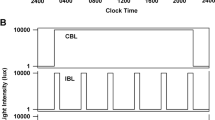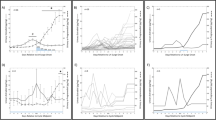Abstract
A seasonal variation in the month of initial detection of breast cancer has been previously observed in pre-menopausal women, and it has been proposed that this may be due to cyclic changes in tumour growth mediated by the effects of melatonin on ovarian function. To investigate this possibility serum melatonin concentrations have been measured every 2 h for 24 h at the summer and winter solstice in 20 pre-menopausal women with previous breast cancer and nine controls. Twelve women had detected their tumour in winter and eight in summer. Overall melatonin secretion assessed by either amplitude of the nocturnal melatonin pulse or the area under the 24 h melatonin curve (AUC) was not different between breast cancer women or controls. However, the amplitude and AUC fell in winter in breast cancer patients (summer to winter 93.6 to 77.5 pg ml-1, P less than 0.002 and 743 to 634 AUC units, P less than 0.005 for amplitude and AUC respectively), whereas the winter minus summer values were significantly positive in controls compared with cancer patients. The abnormal fall in winter values in the women with previous breast cancer was confined to the group of women who had been winter detectors (mean summer to winter levels 94.9 to 72.6 pg ml-1, P less than 0.01 and 775 to 637 AUC units, P less than 0.05 for amplitude and AUC respectively) whereas there was no significant seasonal alteration in these measurements in summer detectors. The acrophase of the nocturnal pulse of serum melatonin was significantly advanced in both groups of women with previous breast cancer (change in acrophase winter to summer from 0210 h to 0140 h in summer detectors, P less than 0.01, 0330 h to 0210 h in winter detectors, P less than 0.05) with a similar although nonsignificant trend in control women. The abnormal reduction of serum melatonin seen in wintertime in winter detectors of breast cancer could promote tumour growth at this season and so contribute to the decreased survival previously observed in this group compared with summer detectors. The relatively normal seasonal profile of melatonin observed in summer detectors could allow increased ovarian steroidogenesis in spring/summer with a resulting increase in tumour growth and consequent rise in tumour detection rate at this time.
This is a preview of subscription content, access via your institution
Access options
Subscribe to this journal
Receive 24 print issues and online access
$259.00 per year
only $10.79 per issue
Buy this article
- Purchase on Springer Link
- Instant access to full article PDF
Prices may be subject to local taxes which are calculated during checkout
Similar content being viewed by others
Author information
Authors and Affiliations
Rights and permissions
About this article
Cite this article
Holdaway, I., Mason, B., Gibbs, E. et al. Seasonal changes in serum melatonin in women with previous breast cancer. Br J Cancer 64, 149–153 (1991). https://doi.org/10.1038/bjc.1991.259
Issue Date:
DOI: https://doi.org/10.1038/bjc.1991.259



